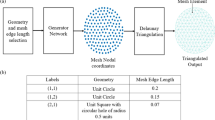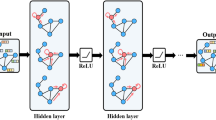Abstract
Mesh generation accounts for a large number of workloads in the numerical analysis. In this paper, we introduce a novel differential method MGNet for structured mesh generation. The proposed method poses the meshing task as an optimization problem. It takes boundary curves as input, employs a well-designed neural network to study the potential meshing (mapping) rules, and finally outputs the mesh with a desired number of cells. The whole process is unsupervised and does not require a priori knowledge or measured datasets. We evaluate the performance of MGNet in terms of mesh quality, network designs, robustness, and overhead on different geometries and governing equations (elliptic and hyperbolic). The experimental results prove that, in all cases, the proposed method is capable of generating acceptable meshes and achieving comparable or superior meshing performance to the traditional algebraic and differential methods. The proposed MGNet also outperforms other neural network-based solvers and enables fast mesh generation using feedforward prediction techniques.













Similar content being viewed by others
References
Chang-Hoi A, Sang-Soo L, Hyuek-Jae L, Soo-Young L (1991) A self-organizing neural network approach for automatic mesh generation. IEEE Trans Magn 27(5):4201–4204. https://doi.org/10.1109/20.105028
Chen X, Liu J, Li S, Xie P, Chi L, Wang Q (2018) Tamm: a new topology-aware mapping method for parallel applications on the tianhe-2a supercomputer. In: Vaidya J, Li J (eds) Algorithms and architectures for parallel processing. Springer, Cham, pp 242–256
Karman SL, Anderson WK, Sahasrabudhe M (2006) Mesh generation using unstructured computational meshes and elliptic partial differential equation smoothing. AIAA J 44(6):1277–1286. https://doi.org/10.2514/1.15929
Pochet A, Celes W, Lopes H, Gattass M (2017) A new quadtree-based approach for automatic quadrilateral mesh generation. Eng Comput 33(2):275–292. https://doi.org/10.1007/s00366-016-0471-0
Liseikin VD (2004) A computational differential geometry approach to grid generation. Springer, Berlin
Lu F, Qi L, Jiang X, Liu G, Liu Y, Chen B, Pang Y, Hu X (2020) Nnw-gridstar: interactive structured mesh generation software for aircrafts. Adv Eng Softw 145:102803. https://doi.org/10.1016/j.advengsoft.2020.102803
Shragge J (2006) Differential mesh generation. SEG Tech Progr Expand Abstr 10(1190/1):2369975
Haynes RD, Howse AJM (2015) Alternating Schwarz methods for partial differential equation-based mesh generation. Int J Comput Math 92(2):349–376. https://doi.org/10.1080/00207160.2014.891733
Brink AR, Najera-Flores DA, Martinez C (2020) The neural network collocation method for solving partial differential equations. Neural Comput Appl. https://doi.org/10.1016/j.jcp.2021.110364
Papagiannopoulos A, Clausen P, Avellan F (2021) How to teach neural networks to mesh: application on 2-d simplicial contours. Neural Netw 136:152–179. https://doi.org/10.1016/j.neunet.2020.12.019
Lu X, Tian B (2010) Research on mesh generation in the finite element numerical analysis based on radial basis function neural network. In: 2010 international conference on computer application and system modeling (ICCASM ), vol 11, pp 157–160. 10.1109/ICCASM.2010.5623240
Chen X, Liu J, Gong C, Li S, Pang Y, Chen B (2021) Mve-net: an automatic 3-d structured mesh validity evaluation framework using deep neural networks. Comput Aided Des 141:103104. https://doi.org/10.1016/j.cad.2021.103104
Chen X, Liu J, Pang Y, Chen J, Chi L, Gong C (2020) Developing a new mesh quality evaluation method based on convolutional neural network. Eng Appl Comput Fluid Mech 14(1):391–400. https://doi.org/10.1080/19942060.2020.1720820
Chen X, Chen R, Wan Q, Xu R, Liu J (2021) An improved data-free surrogate model for solving partial differential equations using deep neural networks. Sci Rep. https://doi.org/10.1038/s41598-021-99037-x
Jin X, Cai S, Li H, Karniadakis GE (2021) NSFnets (Navier–Stokes flow nets): physics-informed neural networks for the incompressible Navier–Stokes equations. J Comput Phys 426:109951. https://doi.org/10.1016/j.jcp.2020.109951
Liang D, Wang Y, Chen C, Liu Y, Wang F (2020) A clustering-based approach to vortex extraction. J Vis. https://doi.org/10.1007/s12650-020-00636-z
Alfonzetti S, Coco S, Cavalieri S, Malgeri M (1996) Automatic mesh generation by the let-it-grow neural network. IEEE Trans Magn 32(3):1349–1352. https://doi.org/10.1109/20.497496
Ahmet Ç, Ahmet A (2002) Neural networks based mesh generation method in 2-d. In: Shafazand H, Tjoa AM (eds) EurAsia-ICT 2002: information and communication technology. Springer, Berlin, Heidelberg, pp 395–401
Zhang Z, Wang Y, Jimack PK, Wang H (2020) Meshingnet: A new mesh generation method based on deep learning. In: Krzhizhanovskaya VV, Závodszky G, Lees MH, Dongarra JJ, Sloot PMA, Brissos S, Teixeira J (eds) Computational Science—ICCS 2020. Springer, Cham, pp 186–198
Huang K, Krügener M, Brown A, Menhorn F, Bungartz H-J, Hartmann D (2021) Machine learning-based optimal mesh generation in computational fluid dynamics .https://arxiv.org/abs/2102.12923
Geuzaine C, Remacle J.-F(2009) Gmsh: a three-dimensional finite element mesh generator with built-in pre-and post-processing facilities.International Journal for Numerical Methods in Engineering 79(11), 1309–1331
Raissi M, Perdikaris P, Karniadakis GE (2019) Physics-informed neural networks: a deep learning framework for solving forward and inverse problems involving nonlinear partial differential equations. J Comput Phys 378:686–707. https://doi.org/10.1016/j.jcp.2018.10.045
Dwivedi V, Srinivasan B (2020) Physics informed extreme learning machine (PIELM)—a rapid method for the numerical solution of partial differential equations. Neurocomputing 391:96–118. https://doi.org/10.1016/j.neucom.2019.12.099
Arthurs CJ, King AP (2021) Active training of physics-informed neural networks to aggregate and interpolate parametric solutions to the Navier-Stokes equations. J Comput Phys. https://doi.org/10.1016/j.jcp.2021.110364
Pedregosa F, Varoquaux G, Gramfort A, Michel V, Thirion B, Grisel O, Blondel M, Prettenhofer P, Weiss R, Dubourg V, Vanderplas J, Passos A, Cournapeau D, Brucher M, Perrot M, Duchesnay E, Louppe G (2012) Scikit-learn: machine learning in python. J Mach Learn Res 12:2825–2830
Abadi M, Barham P, Chen J, Chen Z, Davis A, Dean J, Devin M, Ghemawat S, Irving G, Isard M, Kudlur M, Levenberg J, Monga R, Moore S, Murray D, Steiner B, Tucker P, Vasudevan V, Warden P, Zhang X (2016) TensorFlow: a system for large-scale machine learning. In: Proceedings of the 12th USENIX Conference on Operating Systems Design and Implementation.OSDI’16, pp. 265–283. USENIX Association, USA
Morales J, Nocedal J (2011) Remark on algorithm 778: L-BFGS-B: Fortran subroutines for large-scale bound constrained optimization. ACM Trans Math Softw 38:7. https://doi.org/10.1145/2049662.2049669
Raissi M, Yazdani A, Karniadakis GE (2020) Hidden fluid mechanics: learning velocity and pressure fields from flow visualizations. Science 367(6481):1026–1030. https://doi.org/10.1126/science.aaw4741
Wang S, Teng Y, Perdikaris P(2020) Understanding and mitigating gradient pathologies in physics-informed neural networks.https://arxiv.org/abs/2001.04536
Ramachandran P, Zoph B, Le QV (2017) Searching for activation functions. https://arxiv.org/abs/1710.05941
Acknowledgements
This research work was supported in part by the National Key Research and Development Program of China (2017YFB0202104, 2018YFB0204301).
Author information
Authors and Affiliations
Corresponding author
Ethics declarations
Conflict of interest
The authors have no competing interests to declare that are relevant to the content of this article.
Additional information
Publisher's Note
Springer Nature remains neutral with regard to jurisdictional claims in published maps and institutional affiliations.
Rights and permissions
About this article
Cite this article
Chen, X., Li, T., Wan, Q. et al. MGNet: a novel differential mesh generation method based on unsupervised neural networks. Engineering with Computers 38, 4409–4421 (2022). https://doi.org/10.1007/s00366-022-01632-7
Received:
Accepted:
Published:
Issue Date:
DOI: https://doi.org/10.1007/s00366-022-01632-7




